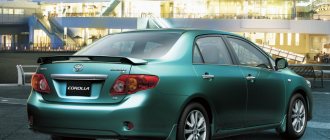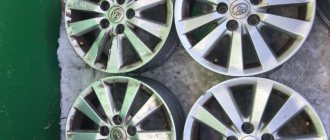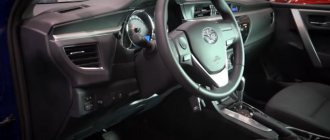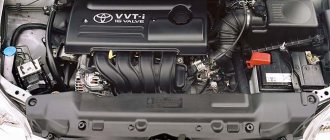The Toyota Ceres sedan was created on the basis of the E100 generation Corolla and was distinguished by a body with a central pillar and doors without frames. The car was developed for the Japanese domestic market and began to be assembled in 1992. Deliveries continued for 6 years. There was a version of the Sprinter Marino sedan, which differed in the design of the front and rear parts of the body.
Toyota Ceres was created based on the E100 generation.
Description of Toyota Corolla Ceres
The Ceres car is distinguished by neat body lines, on which the number of protruding elements is minimized. The first photographs, officially shown by Toyota a year before the start of deliveries, ensured the popularity of the model in Japan.
Toyota Ceres were painted with standard enamels or paints with the addition of metal powder (5 colors were available). Bumpers, door handles and mirror housings were painted by default.
What it looks like (photo)
The photo shows a Toyota Ceres, which was equipped with narrow head optics with a small radiator grille. Additional air intakes were located in the massive bumper. The rear doors were designed to overlap the wing, making it easier to board and disembark passengers. There was a plastic protective trim on the side panels of the doors. The narrow aft lighting equipment was separated by a black panel mounted on the trunk lid. The model designation was printed in large letters on the bumper below the luggage compartment opening.
Toyota Ceres was equipped with narrow head optics.
Dimensions and weight
Main dimensions and weight of the Ceres car:
- body length – 4365 mm;
- wheelbase – 2465 mm;
- track – 1460 and 1450 mm (front and rear);
- width – 1695 mm;
- height – 1315 mm;
- interior length – 1795 mm;
- ground clearance - at least 140 mm;
- curb weight – from 1010 to 1120 kg.
Interior
Soft plastic and natural fabrics were used in the interior decoration (on expensive modifications, the chairs and door cards were covered with velor). The front seats with separate adjustments were equipped with headrests. Standard equipment included an analog instrument cluster with a tachometer. Illumination lamps were provided on the ceiling lining and rear pillar trims. The door cards had pockets for bottles. High-quality interior trim ensured reduced noise when driving.
The interior of the cabin is made of natural fabrics and plastic.
Brief description of the car
The appearance of the Toyota Corolla brand Ceres attracted attention with its smooth contours and sleek lines of the body and hood; the narrow radiator grille was perfectly combined with the same width elongated head optics.
There are no unnecessary lines on the body profile, into which doorways without window frames fit so organically. The appearance of the car is presented in numerous photos on the Internet.
The trunk and rear bumpers were of the same rounded shape, the lights were slightly wider than the headlights, but proportionate in length. Body-colored exterior side mirrors and bumpers were offered for this model in the simplest configuration.
With a wheelbase of 2465 mm, the interior of the 1992 Ceres is quite roomy, but there is not enough room for three people sitting on the back seat. The dashboard is made of soft foam, as is the instrument panel. The instrument dials are of optimal size and the readings are easy to read. There is a small display that shows the time of day in normal mode, but when a malfunction occurs, it makes a sound and hieroglyphs appear indicating its nature (the instructions contain a translation with a photo of the hieroglyphs).
The front seats of the 1993 Ceres are very comfortable, have support and all the necessary adjustments. The steering wheel and control knobs are pleasant to the touch. Climate control panel with backlit buttons, the color of which can be changed. The entire interior is made of soft gray velor. A spacious trunk allows a family with children to place the things they need on the road and go on a trip.
Options and modifications of Toyota Ceres
The Ceres car was created taking into account stricter safety requirements and complied with the new (at the beginning of the 90s of the last century) internal CIAS standard. Basic equipment included power windows and a folding rear bench. Provision was made for adjusting the driver's seat in height and adjusting the steering column according to the installation angle. Some Ceres sedans had an ABS system and an airbag in the steering wheel hub. An electric sunroof and a sound system with 6 or 8 speakers were offered as options.
F Type
The base Toyota Corolla Ceres produced in 1992 was equipped with a 1.5-liter engine and featured a simplified interior trim. From the factory, the car used stamped wheels with a diameter of 13″. The front suspension lacked an anti-roll bar. The climate control system (air conditioning was optional) had a lever control unit. Models were offered with manual or automatic transmission.
The base Toyota used stamped wheels.
X Type
Level X provided for the installation of a 1.6 liter engine with an automatic or manual transmission. Externally, the car was distinguished by 14-inch wheels (stamped or made of aluminum alloy). The interior of the Ceres sedan had improved seat trim and door panels. The climate control system was controlled by rotary knobs and keys.
The X Type modification has a 1.6 liter engine.
Upon request, a system for automatically maintaining the set air temperature was used.
G Type
Version G was aimed at supporters of a dynamic driving style and was equipped with an engine with a variable valve timing system. The chassis used springs and struts with increased rigidity. On the rear wheels, instead of drum mechanisms, there were disks with a floating bracket. Spacers were provided between the pillars to increase body rigidity. For all vehicle equipment options, an Extra Package was offered, which provided an increased level of comfort for the driver and passengers.
The G Type version is aimed at a dynamic driving style.
Technical parameters and configurations
The 1992 Toyota Corolla Ceres had three trim levels from the very beginning. The simplest of them, the F Type, featured a fabric interior, electrically operated window lifts and bumpers painted to match the color of the car.
Other options were priced separately and included a rear windshield wiper, power-adjustable driver's seat, sport-style trunk spoiler, driver's airbag and alloy wheels.
This configuration was equipped with a 1.5-liter engine with 105 horsepower, running on gasoline. The transmission for this engine is a five-speed manual gearbox or a 4-speed automatic. The entire suspension was strut type, there was no anti-roll bar at the front. This configuration, designed for middle-income customers, was the most affordable and economical.
The mid-spec X Type Toyota Corolla Ceres 1993 was equipped with engines developing 115 hp. With. The car was equipped with a leather steering wheel and transmission selector, a velor interior, and a spoiler on the trunk lid was an additional, separately paid option.
Together with 16 or 20-valve engines, a 5-speed manual transmission or a 4-band automatic transmission with electronic control was relied upon.
The third set of G Type for the 1993 Toyota Ceres was equipped with 1.6-liter engines with a VVTi system and a power of 160 horses. The engines were paired with a five-speed manual or automatic transmission. The suspension system was equipped with shock absorbers with increased rigidity. In addition to the options available in the F and X trim levels, it was necessary to install a higher-quality sound reproduction system and a multi-display.
Interestingly, in addition to these trim levels, there were two more – F Limited and X Limited. They were delivered several times a year in small batches - these were cars painted completely black (metallic), they were called Black Ceres, they can be seen in the photo.
All trim levels were equipped with 4-cylinder economical engines with an average consumption of about seven and a half liters per hundred kilometers.
The year 1994 was marked by a minor restyling of the Toyota Corolla Ceres; its technical characteristics generally remained the same, and in 1995 the car was equipped with a more powerful and economical 165 hp engine. With. Judging by the photo and review from 1997, the transmission of this sedan received a new six-speed automatic.
Technical characteristics of the car
Toyota Ceres is equipped with an all-metal monocoque body, the design of which includes zones with programmable deformation. The power unit is mounted across the engine compartment on supports that reduce vibration levels.
The on-board electrical network is equipped with a lead-acid battery and an alternator with an automatic voltage regulator.
Engine
Ceres used 4-cylinder engines with an EFI fuel injection system. The base 5A-FE had a volume of 1498 cm³ and developed 100 hp. With. at 5600 rpm. For the average level of equipment, a 1.6-liter 110-horsepower version 4A-FE was available. Model G was equipped with a 4A-GE engine with a compression ratio increased to 11 units and modified valve timing. The engine developed 165 hp. With. at a crankshaft speed of 7800 rpm.
Chassis
The Corolla Ceres was equipped with a hydraulic brake system with a booster and a 4-channel ABS unit. Ventilated discs were used at the front, drums or solid discs were used at the rear. Stamped wheel rims were equipped with plastic caps with the Toyota plant emblem. Light alloy wheels were installed on some of the cars. Tire sizes ranged from 175/70R13 to 195/60R14 (depending on engine type), the spare wheel was of a reduced size.
Toyota Ceres was equipped with a hydraulic braking system.
Suspension and transmission
The Toyota Ceres used a 5 or 6-speed manual transmission with a 1-disc clutch. Torque was transmitted to the front wheels. For an extra charge, a 4-speed automatic transmission with a torque converter was offered. The front suspension with MacPherson struts could be equipped with a stabilizer. An independent lever design was installed at the rear. To secure the chassis there were welded subframes.
Road handling
Toyota Ceres was equipped with hydraulic power steering. The pump was located on the engine cylinder block and had a belt drive. The controls were responsive, but owners experienced fluid leaks due to aging hose seals.
The rack-and-pinion mechanism was highly reliable, but the condition of the anthers had to be monitored.
Gasoline consumption
The fuel used was gasoline with an octane rating of at least 95 units (the version with the 4A-GE engine required a fuel grade of at least A-98). A fuel tank with a capacity of 50 liters was located under the underbody of the Corolla Ceres car. The average consumption according to the Japanese measurement method ranged from 11 to 18.8 km per 1 liter of fuel (equivalent to values from 5.3 to 9.1 liters per 100 km). In dense city traffic, the parameter varied from 10 to 14 liters per 100 km.
Gasoline consumption was up to 18.8 km per 1 liter of fuel.
Other parameters
The Corolla Ceres sedan could be equipped with additional electrical equipment. The factory offered a power-operated driver's seat and another wiper to clean the rear window. Fuse and relay boxes were located in the engine compartment and instrument panel of the car.
Latest restyling and completion of release
The third modification of Toyota Ceres is the maximum configuration. The engine is capable of producing up to 160 hp. With. It differed in that a VVT variable valve timing system was installed here. These cars were equipped with a velor interior, stiffer shock absorbers were installed, as well as a two-pipe muffler, which distinguished this modification from the rest. It is also worth noting the presence of a rear window wiper, side airbags, a multi-display and a premium audio system.
In 1995, the model underwent restyling. The changes affected the installation of an improved suspension, exhaust system and power unit. Production was discontinued in 1998.
Latest modification of Toyota Ceres
Shipping of Toyota Corolla Ceres from the plant ceased in early July 1998, but dealers sold inventory for a year and a half. Sedans could be equipped with a navigation system that downloaded a map from a CD. The standard equipment included a driver and front passenger airbag and an ABS unit (became installed by default from mid-1997). The characteristics of the 4A-FE engine were slightly changed, which made it possible to smooth out the torque curve and reduce gasoline consumption.
Restyling of Toyota Ceres
At the end of spring 1994, Ceres cars underwent modernization, which slightly changed the outline of the front bumper and radiator grille. Sedans also received new taillights, but the body panels and trim remained unchanged. Aluminum wheels changed only in the summer of 1997. At the same time, a 6-speed manual transmission began to be used (for the G-Type model).
In 1994, Ceres underwent modernization.
Features of maintenance and tuning
Ceres cars have high mileage. Regular maintenance is required to keep equipment in good condition. The oil change interval is 7–8 thousand km. No special equipment is required to perform repair work. Toyota Corolla Ceres was popular among tuning enthusiasts, who modified engines and improved aerodynamics by installing new bumpers or additional wings. The maintenance of this model is no different from the maintenance of other Japanese-made cars assembled in the 90s. last century.










